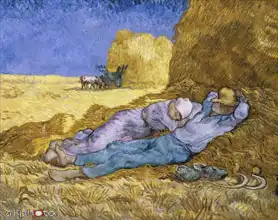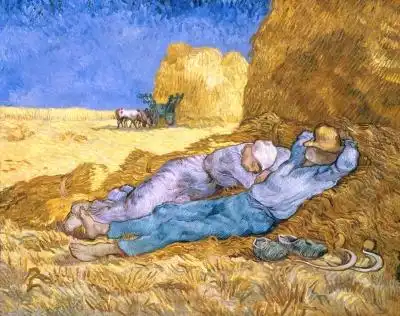About this finishing
Print. The image is printed on the top quality 10-ink HP Z9PS printer on HP matte 270 g / m2 paper. You can choose any size to an accuracy of 1 cm. A margin of 5 cm around the image is added to the size of the motif.


You can find a detailed description about our finishings
here.
Midday rest
Date:
1890Medium:
oil on canvasLocation:
Musee d'Orsay, Paris, FranceDimensions:
73 x 91The painting "Midday rest" by
Van Gogh was created in 1890, shortly before his death. This painting is sometimes also called "Siesta" or "Orphans", and it is an oil painting on canvas. The painting "Midday rest" depicts a rural scene. It is a view of a field that is surrounded by trees and lush
nature . This rural landscape was a frequent motif in van Gogh's works. In the foreground of the painting we see several figures resting in a field. They are field workers taking a break during the day. Their figures are depicted in van Gogh's typical
expressionist style, with strong brush strokes and bright colors. The painter tried to capture the effects of light and shadows on the field and on the figures. Sunlight creates contrasts and adds vibrancy to the image.
Van Gogh used short, visible brushstrokes that create texture in the field and in the clothing of the figures. This texture adds an impression of movement and life. The painting exudes a sense of calm and rest, which is typical of many of van Gogh's rural scenes. The
characters are resting and enjoying the beauty of nature.
Gogh painted picture Midday rest in 1890. Prevailing color of this fine art print is yellow and its shape is landscape. Original size is 73 x 91. This art piece is located in Musee d'Orsay, Paris, France. This image is printed on demand - you can choose material, size and finishing.
Vincent Willem van Gogh (1853-1890). Dutch painter belonging to
Post-Impressionism. His paintings (some 900 paintings and 1,100 drawings and sketches) are among the most famous in the world and are sold for exorbitant sums (except for those in our shop).
Parisian Impressionists He lived in Paris from 1886 and was influenced by the use of bright colours - most of his works were painted during this period. In his paintings, Gogh uses contrasting colours (often blue and orange - he said that I want to use colours other contrasts to each of them shone even more to contrast a man and a woman). He was known for his excesses and amputated an ear after the break-up of his friendship with
Gauguin. There is a lot of speculation about this incident (he possibly suffered from heavy metal poisoning from paint that had caused mental problems). In 1890, unfortunately he committed suicide.

